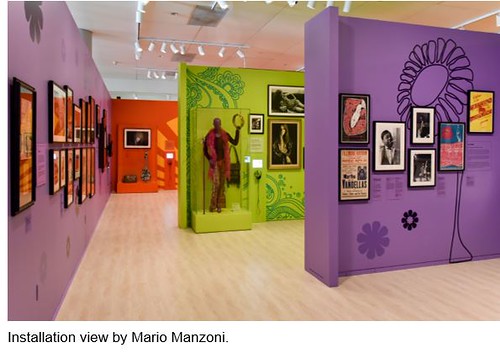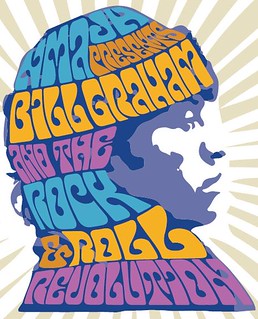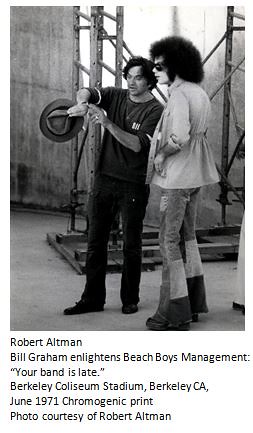 The National Museum of American Jewish History(NMAJH) is the exclusive East Coast venue for Bill Graham and the Rock & Roll Revolution. On view through January 16, 2017, the exhibition presents the first comprehensive retrospective about the life and career of legendary rock impresario Bill Graham (1931–1991). Recognized as one of the most influential concert promoters in history,Graham played a pivotal role in the careers of iconic artists including theGrateful Dead, Jefferson Airplane, Janis Joplin, Jimi Hendrix,Santana, Fleetwood Mac, the Who, Led Zeppelin, the Doors, and theRolling Stones. He conceived of rock & roll as a powerful force for supporting humanitarian causes and was instrumental in the production of milestone benefit concerts such as Live Aid (1985)—which took place in Philadelphia and London—and Human Rights Now! (1988). The Museum is open late on Wednesday nights (until 8 pm) throughout the run of the show.
The National Museum of American Jewish History(NMAJH) is the exclusive East Coast venue for Bill Graham and the Rock & Roll Revolution. On view through January 16, 2017, the exhibition presents the first comprehensive retrospective about the life and career of legendary rock impresario Bill Graham (1931–1991). Recognized as one of the most influential concert promoters in history,Graham played a pivotal role in the careers of iconic artists including theGrateful Dead, Jefferson Airplane, Janis Joplin, Jimi Hendrix,Santana, Fleetwood Mac, the Who, Led Zeppelin, the Doors, and theRolling Stones. He conceived of rock & roll as a powerful force for supporting humanitarian causes and was instrumental in the production of milestone benefit concerts such as Live Aid (1985)—which took place in Philadelphia and London—and Human Rights Now! (1988). The Museum is open late on Wednesday nights (until 8 pm) throughout the run of the show.
Graham mounted his first concert, a benefit to support the legal defense of one of the Mime Troupe’s actors, featuring an eclectic mix of performers including the Fugs, Lawrence Ferlinghetti, and Jefferson Airplane. It was a transformative moment: Graham had discovered his calling. He soon took over the lease on San Francisco’s famed Fillmore Auditorium, where he produced groundbreaking shows throughout the ’60s—including sold-out concerts by the Grateful Dead, Cream, Big Brother & the Holding Company, and the Doors, before going on to present pivotal shows by Jimi Hendrix; Crosby, Stills, Nash & Young; Bob Dylan; and The Band at his venues in San Francisco and New York City. Graham’s mastery at promoting, marketing, and managing artists propelled him to become one of rock & roll’s most influential figures.
 Bill Graham and the Rock & Roll Revolution was organized by the Skirball Cultural Center, Los Angeles. Featuring iconic psychedelic concert posters, rock memorabilia, photographs, films, and ephemera, the exhibition explores the momentous cultural transformations of the ’60s, ’70s, and ’80s through the lens of rock & roll. The exhibition includes more than 200 objects from lenders across the country—many being shown in public for the first time, includingJanis Joplin’s tambourine, Pete Townshend’s 1968 Gibson SG Special used during a performance of Tommy, and Graham’s personal scrapbooks. Rarely displayed treasured photographs and artifacts from Graham’s early life and career are on loan from the Graham family. Also for the first time ever, preparatory drawings and the original artwork of several iconic Fillmore concert posters are on museum display, revealing the signature visual styles and creative process of poster artists Bonnie MacLean, Wes Wilson, David Singer, and Greg Irons.Unique to NMAJH’s run of the exhibition are a number of items from Philadelphia’s Live Aid concert, including an original event program and ticket stub, a pickguard signed by Mick Jagger and David Bowie, and a microphone signed by Ozzy Osbourne. A New Year’s Eve themed concourse takeover featuring Graham’s famous Father Time costume is featured, as well as an installation of “The Joshua Light Show,” the trailblazing liquid light show conceived in 1967 by multimedia artist Joshua White, which served as a backdrop to many Graham-produced concerts.
Bill Graham and the Rock & Roll Revolution was organized by the Skirball Cultural Center, Los Angeles. Featuring iconic psychedelic concert posters, rock memorabilia, photographs, films, and ephemera, the exhibition explores the momentous cultural transformations of the ’60s, ’70s, and ’80s through the lens of rock & roll. The exhibition includes more than 200 objects from lenders across the country—many being shown in public for the first time, includingJanis Joplin’s tambourine, Pete Townshend’s 1968 Gibson SG Special used during a performance of Tommy, and Graham’s personal scrapbooks. Rarely displayed treasured photographs and artifacts from Graham’s early life and career are on loan from the Graham family. Also for the first time ever, preparatory drawings and the original artwork of several iconic Fillmore concert posters are on museum display, revealing the signature visual styles and creative process of poster artists Bonnie MacLean, Wes Wilson, David Singer, and Greg Irons.Unique to NMAJH’s run of the exhibition are a number of items from Philadelphia’s Live Aid concert, including an original event program and ticket stub, a pickguard signed by Mick Jagger and David Bowie, and a microphone signed by Ozzy Osbourne. A New Year’s Eve themed concourse takeover featuring Graham’s famous Father Time costume is featured, as well as an installation of “The Joshua Light Show,” the trailblazing liquid light show conceived in 1967 by multimedia artist Joshua White, which served as a backdrop to many Graham-produced concerts.Join the conversation on Facebook, Instagram, and Twitter with the hashtag #GrahamRocks.
No comments:
Post a Comment